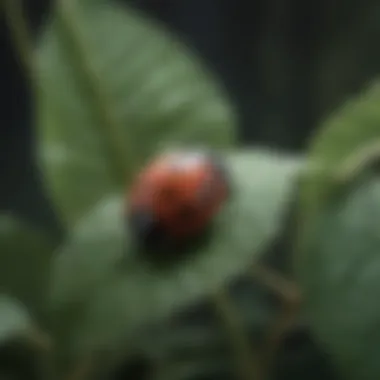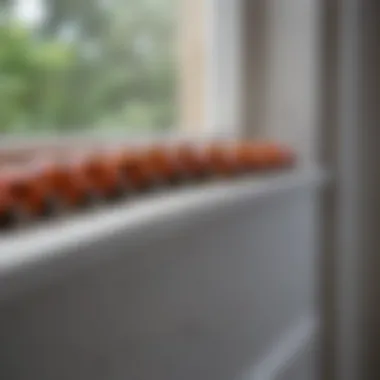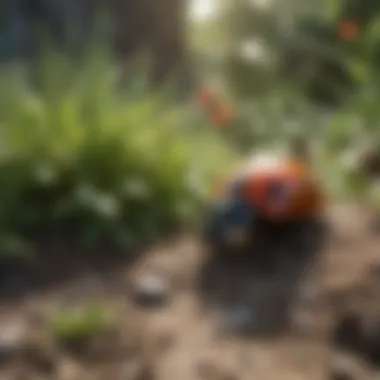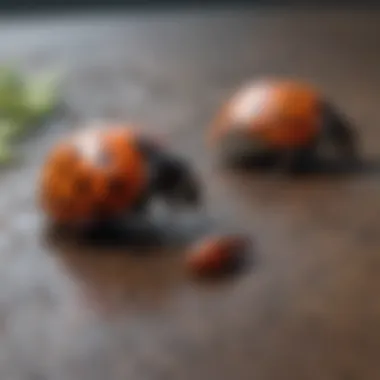Understanding Ladybugs: Nature's Tiny Allies in Homes


Intro
Ladybugs, often recognized for their distinct appearance, have long captivated home dwellers. Their presence in residential spaces raises questions about their habits and benefits. Understanding why ladybugs enter our homes can bridge the gap between curiosity and practical knowledge. This article delves into various aspects of these insects, shedding light on their ecological roles and how to manage their presence effectively.
Key Insights and Trends
Current Trends in Interior Design
The popularity of incorporating natural elements in interior design has grown. Homeowners are embracing biophilia in their spaces, which includes the presence of ladybugs. These insects can be seen as a sign of a healthy indoor environment. Moreover, the color palette often includes reds and blacks, mirroring the ladybug's colors. This color scheme further highlights the aesthetic value of having such insects around, albeit unintentionally.
Popular Gardening Techniques of the Season
As the gardening scene evolves, more individuals are adopting organic gardening practices. Ladybugs play a crucial role as natural pest controllers, effectively managing aphids and other harmful insects. With the increase of container gardening during the spring months, ladybugs are likely to follow. They assist in maintaining balance within these small ecosystems.
Understanding Ladybugs' Outdoor Habitats
Ladybugs prefer moist environments and can be found in gardens, parks, and fields.
- Natural Shelter: They often hide beneath leaves or stones when it rains.
- Food Sources: Gardens that host aphid infestations attract ladybugs, providing the necessary sustenance for these insects.
By recognizing their habitats, homeowners can better anticipate when these insects might arrive indoors.
The Biological Characteristics of Ladybugs
Ladybugs belong to the family Coccinellidae. They are soft-bodied beetles that come in various colors. The classic ladybug is red with black spots. However, they can also be yellow, orange, or even black. Understanding these variations can help homeowners identify them correctly. Their life cycle includes four stages: egg, larva, pupa, and adult.
This cycle typically occurs in spring and early summer, leading to an increase in indoor encounters as they seek warmth during colder months.
Benefits of Ladybugs in Gardening
Having ladybugs around is advantageous for those interested in gardening.
- Natural Pest Control: They actively consume harmful pests such as aphids, mites, and whiteflies.
- Biodiversity Support: Ladybugs contribute to garden biodiversity, enhancing overall ecological balance.
These benefits can often mitigate the need for chemical pesticides, creating a healthier gardening practice.
Recognizing the Need for Management
While ladybugs hold ecological significance, their presence inside homes can become bothersome. Homeowners should be prepared for occasional invasions.
Practical Tips for Managing Ladybugs
- Seal Entry Points: Check windows and doors for gaps and seals.
- Reduce Light Attractiveness: Install screens to decrease light exposure at night.
- Utilize Non-toxic Deterrents: Certain natural sprays can repel them without harming beneficial insects.
Final Thoughts
Understanding ladybugs is not only about embracing their charm. It's also about acknowledging their role in pest management and the impact on the indoor ecosystem.
Prelims
In the intricate relationship between humans and nature, the presence of ladybugs in residential spaces serves as a fascinating intersection of ecological balance and interior aesthetics. Understanding why these small beetles find their way into homes is essential for homeowners, gardening enthusiasts, and anyone interested in maintaining a healthy indoor environment. Ladybugs are often perceived as harmless, even beneficial, given their role in controlling aphid populations. However, their occurrence within residential areas raises questions about the environmental conditions that attract them and the potential implications for indoor spaces.


The significance of this topic lies not only in its ecological relevance but also in the practical considerations it introduces for homeowners. Knowing the biological characteristics of ladybugs, their habitat preferences, and the reasons behind their seasonal migrations can empower individuals to manage their presence more effectively. By recognizing the characteristics of ladybugs, one can appreciate their role in the ecosystem while also addressing any challenges they may pose.
Additionally, the integration of ladybugs into the discourse about indoor spaces speaks to broader themes in pest management and sustainable gardening practices. With increasing interest in natural methods for pest control, the ladybug emerges as a symbol of harmony between effective practices and the preservation of biodiversity.
In exploring the multifaceted aspects of ladybugs, this article aims to provide valuable insights. It serves as a guide for navigating their presence within homes and contributes to a deeper understanding of the ecological dynamics at play.
Ladybugs are not just charming insects; they play a critical role as pest controllers and indicators of a healthy environment.
Biological Characteristics of Ladybugs
Understanding the biological characteristics of ladybugs is crucial for several reasons. First, it can help homeowners appreciate their role in the ecosystem. Second, it aids in identifying different species present in residential areas. Lastly, recognizing their life cycle can provide insights into the timing of their appearances, which is important for effective management.
Physical Features
Ladybugs, also known as ladybird beetles, display a range of physical features which contribute to their identification. These insects are generally small, ranging from two to ten millimeters in length. Their most distinctive feature is their brightly colored exoskeleton, which typically has a shell of red or orange with black spots. However, some species exhibit variations, including yellow or black colors.
Ladybugs possess a rounded body that can sometimes be confused with other beetles. The shape is an adaptation that aids in protecting them from predators. Their wings are another notable feature. Unlike many insects that are loud in flight, ladybugs can fly quietly, which helps them conserve energy. The anatomy of their mouthparts is designed for chewing, allowing them to feed effectively on soft-bodied pests like aphids.
Lifecycle and Reproduction
The lifecycle of ladybugs is fascinating and can influence their presence in residential spaces. They undergo a complete metamorphosis consisting of four stages: egg, larva, pupa, and adult. Female ladybugs can lay thousands of eggs in a single season, typically near colonies of aphids, which serve as food for the larvae after they hatch.
After a few days, the eggs hatch into larvae, which are voracious eaters. They will molt several times before transitioning into the pupal stage. The pupal stage lasts about a week, during which the larvae undergo significant transformation. Upon emerging as adults, ladybugs seek to establish their territory, often leading them into homes during specific seasons, particularly in the fall as they search for places to overwinter. Understanding this lifecycle is crucial for knowing when ladybugs will likely appear indoors and to ensure proper management strategies are in place.
Species Variations
Ladybugs encompass a wide variety of species, each with unique characteristics and habitat preferences. In total, there are over 6,000 species worldwide. In North America, the most common types include the seven-spotted ladybug, the twice-stabbed ladybug, and the convergent ladybug. These variations in species have adapted to specific environments and food sources, influencing their mobility and behavior.
Some species, like the Asian lady beetle, have become particularly notable in residential areas due to their ability to thrive in diverse habitats, including urban settings. Their presence can be beneficial as they control pest populations, but they also present challenges for homeowners due to their propensity to invade living spaces. Knowing the differences among species is essential for homeowners, as it helps in choosing the right management techniques and understanding the ecological roles these insects play.
Habitat Preferences of Ladybugs
Understanding the habitat preferences of ladybugs offers valuable insight into why they frequently inhabit residential spaces. Ladybugs thrive in environments that provide their basic needs for survival, including food, shelter, and a suitable climate. The behavior and distribution of ladybugs can influence their occurrence in homes, shaping the interactions they have with human living areas. Exploring their habitat helps homeowners appreciate their role in pest control while also addressing the potential issues that arise from having them indoors.
Natural Habitats
Ladybugs typically inhabit a variety of natural environments, including forests, grasslands, and gardens. They tend to prefer areas rich in vegetation, where they can find a steady food source. Ladybugs primarily feed on aphids and other small insects, making gardens an ideal place for them to thrive. The presence of flowering plants can attract ladybugs, as these plants often harbor aphids.
In natural settings, ladybugs use foliage as shelter, particularly during adverse weather conditions. Leafy areas provide not only refuge from predators but also a place to lay eggs. The lifecycle of ladybugs is closely tied to the seasonal availability of food resources. When their natural habitats are disrupted, ladybugs may seek alternative locations, which can include homes.
Adaptation to Domestic Environments
Ladybugs show considerable adaptability to domestic living conditions. Often, they are drawn to homes primarily due to the warmth and light that these spaces provide, particularly during colder months. As temperatures drop outside, ladybugs may enter houses seeking a safe place to spend the winter.
In addition to warmth, homes can offer food sources, especially if there are gardens nearby. The connectiñon between gardens and homes creates a transition zone for ladybugs, allowing them to move freely between the two spaces. Some homeowners might notice ladybug populations increasing in spring as these insects emerge from their winter hiding spots.
Furthermore, homes may contain specific entry points that ladybugs exploit, such as cracks in windows or doors. Being small and agile, they can easily navigate through minor openings to access the interior spaces. This adaptation, while beneficial for ladybugs, can sometimes lead to concerns for homeowners regarding the management of these insects indoors.
"Ladybugs demonstrate a remarkable adaptability, managing to thrive in environments altered by human activity."
In summary, the habitat preferences of ladybugs are integral to understanding their presence in residential areas. Addressing their natural habitat and adaptability can help homeowners grasp the significance of these fascinating insects, while also preparing them for potential encounters.
Reasons for Occurrence in Houses


Understanding the reasons why ladybugs are found in residential spaces is essential for homeowners and gardening enthusiasts alike. Recognizing their patterns and preferences helps mitigate any unintended consequences while allowing households to benefit from their presence. Ladybugs are often welcomed as natural pest controllers, but their arrival in homes can raise concerns for interior aesthetics and home maintenance.
Seasonal Migration Patterns
Ladybugs are known for their seasonal migration behaviors, primarily influenced by changes in climate and food availability. Each year, as temperatures drop during the fall, ladybugs seek out warmer environments, often leading them toward residential areas. This migration is not random; rather, it is a survival strategy that allows them to endure harsh weather conditions.
Many species, such as the Harmonia axyridis, will congregate in large numbers in sheltered places. It is during this time that they can inadvertently find their way into homes through small cracks or open windows. Understanding these patterns helps homeowners anticipate their appearance and take proactive measures.
Attraction to Light and Warmth
An interesting aspect of ladybugs is their attraction to light and warmth. During colder months, light sources become particularly appealing. Homes, with their artificial illumination, attract ladybugs that are simply searching for heat. This attraction is not only due to temperature but also the brightness of indoor lights.
Homeowners often notice clusters of ladybugs near windows or light fixtures. This phenomenon highlights a unique relationship between ladybugs and human dwellings. To minimize their presence, consider using more subdued lighting options or installing screens on windows to allow natural illumination without inviting these insects inside.
Access Points into Homes
Ladybugs can access homes through various entry points that may not be obvious. They can exploit small cracks in walls, gaps around door frames, or spaces near foundations. Homeowners should be diligent in sealing such openings to prevent entry. This is especially important during the fall migration period when ladybugs are actively seeking shelters.
To minimize access points, consider the following approaches:
- Inspect exterior walls for any noticeable cracks or gaps.
- Seal openings with caulk or other appropriate materials to block potential entry.
- Install screens on doors and windows to provide an additional barrier.
"Being proactive about sealing entry points can significantly reduce the likelihood of ladybug invasions."
By understanding the reasons behind ladybug occurrences in homes, one can adopt strategies that respect their ecological benefits while protecting personal living spaces. The balance between encouraging beneficial insects and maintaining a comfortable home is achievable with informed awareness.
Impact of Ladybugs in Indoor Environments
The presence of ladybugs in indoor environments can evoke a diverse range of reactions among homeowners. While some might appreciate their existence, often associating them with good luck or natural beauty, others may view them as unwelcome intruders. Understanding the impact of ladybugs indoors is key to evaluating their ecological benefits, potential drawbacks, and best management practices.
Benefits as Natural Pest Controllers
Ladybugs are widely recognized for their role as natural pest controllers. They primarily feed on aphids, spider mites, and other soft-bodied insects which are common pests in gardens and homes. By keeping these pest populations in check, ladybugs contribute to a healthier indoor environment and, by extension, a more pleasant living space.
The benefits of ladybugs extend beyond aesthetics. Their predatory nature significantly reduces the need for chemical pesticides. Homeowners who advocate for organic gardening and pest management will find ladybugs an asset in maintaining plant health. This alignment with environmentally friendly practices can lead to
- Increased Biodiversity: Having ladybugs can enhance the ecological balance in gardens and lawns, promoting a variety of species cohabitation.
- Lower Maintenance Costs: With fewer pests around, homeowners may incur less expense on pest control solutions.
The effectiveness of ladybugs as natural pest controllers makes them an excellent option for non-toxic pest management strategies.
Potential Concerns for Homeowners
Despite their advantages, ladybugs can also pose concerns for homeowners. One common issue is their tendency to congregate in large numbers when seeking warmth during colder months. This behavior can lead to infestations, particularly in the autumn season, when they look for suitable places to overwinter. Their presence can be startling for residents and may create discomfort.
Additionally, some ladybug species can exude a foul-smelling secretion when threatened, which may leave stains on furniture or walls. This secretion can also cause allergic reactions in sensitive individuals.
Key concerns about ladybugs include:
- Infestation Risk: An excessive number of ladybugs indoors can lead to headaches, especially for those unfamiliar with their habits.
- Allergic Reactions: Certain allergic responses might occur, which necessitates careful observation.
Understanding these factors allows homeowners to appreciate ladybugs' benefits while also preparing for any potential challenges their presence may bring.
Management Strategies for Homeowners


The presence of ladybugs in residential spaces is often seen as a benign phenomenon, yet their invasion into homes may call for strategic management. Recognizing ladybugs as beneficial insects is important; however, understanding how to deal with them effectively can prevent confusion and discomfort. This section discusses several strategies for managing ladybugs, focusing on preventive measures, safe removal techniques, and when to seek professional help.
These management strategies are essential not only for maintaining a harmonious living environment but also for preserving the natural benefits these insects offer. By implementing these techniques, homeowners can minimize the impact of ladybugs indoors while promoting a healthy ecosystem.
Preventive Measures
Preventive measures play a crucial role in managing ladybug populations in homes. Awareness and proactive steps can discourage ladybugs from entering residential areas. Here are some effective preventive strategies:
- Seal Entry Points: Inspect the exterior of your home for cracks or gaps that may serve as entry points for ladybugs. Pay close attention to windows, doors, and utility openings. Sealing these gaps with caulk or weatherstripping can effectively reduce entry chances.
- Maintain Cleanliness: Keeping indoor areas tidy is important. Ladybugs may be attracted to food residues or clutter. Regularly cleaning surfaces and vacuuming can deter them from taking residence in your home.
- Control Outdoor Habitat: Create a less hospitable environment for ladybugs near your home. Keep vegetation well-trimmed and remove preferred host plants from the immediate vicinity, thereby lowering the chances of an indoor invasion.
These preventive measures are invaluable for homeowners looking to minimize ladybug presence indoors.
Safe Removal Techniques
If homeowners find themselves with ladybugs inside, knowing how to remove them safely is vital. Here are techniques that can be employed:
- Use a Soft Brush: Gently sweep ladybugs into a container using a soft brush. This method allows for easy relocation without harming the insect.
- Vacuuming: For larger infestations, using a vacuum with a hose attachment can be effective. Ensure the vacuum bag is emptied outside promptly to prevent ladybugs from returning.
- Non-Toxic Traps: Creating traps with simple ingredients can be beneficial. A mixture of sugar and water in a small container can attract ladybugs, allowing for easy capture.
Employing these safe removal techniques helps ensure that ladybug populations are managed humanely and does not disrupt their ecological role.
"Ladybugs, while sometimes viewed as pests, contribute positively to gardens and indoor environments as natural pest controllers."
Professional Pest Control Options
In some cases, despite best efforts, ladybug infestations can become overwhelming, necessitating professional pest control options. It is crucial to consider the following:
- Consulting Experts: Professional pest control services have the knowledge and tools to handle larger infestations effectively while preserving beneficial insects' roles.
- Integrated Pest Management (IPM): Many pest control companies adopt the IPM approach, combining preventive measures, monitoring, and safe removal methods to manage ladybugs strategically.
- Biodiversity Conservation: Choosing a pest control service that prioritizes minimal harm to the environment ensures that ladybugs can continue their natural work outside, while your home remains comfortable.
By understanding these professional pest control options, homeowners can take informed actions when faced with persistent ladybug presence. This ensures that management is not only effective but also ecologically responsible.
In summary, the management of ladybugs in residential spaces involves a combination of preventive measures, safe removal techniques, and professional options when needed. These strategies provide homeowners with valuable tools to maintain their living environments while respecting the ecological roles ladybugs play.
Cultural Perspectives on Ladybugs
Cultural perspectives on ladybugs offer an intriguing view into how these insects are perceived across various societies. This topic enriches our understanding of ladybugs beyond their ecological role and highlights the connection humans have with nature. By exploring folklore, symbolism, and how ladybugs are represented in art and media, we can appreciate their multifaceted role in human culture and personal spaces.
Folklore and Symbolism
Ladybugs are steeped in folklore, often seen as symbols of good luck and protection. In many cultures, these insects are believed to bring happiness and prosperity. For instance, in some European traditions, spotting a ladybug can signify a coming fortune. The number of spots on a ladybug may also hold different meanings in various cultures. In parts of the United Kingdom, for example, it is said that the more spots a ladybug has, the more luck it brings.
In addition to luck, ladybugs are symbols of motherhood and fertility in different folklore. They are sometimes associated with the Virgin Mary in Christian symbolism, which further enhances their positive image. Many even believe that if a ladybug lands on a person, their wishes will be granted once it flies away. Such beliefs contribute to the ladybug's presence not just in nature but also in home decor, lending an air of comfort and hope to residential spaces.
Ladybug Representation in Art and Media
The representation of ladybugs in art and media carries significant meaning. In many artistic expressions, ladybugs symbolize gentleness, harmony, and the balance of nature. They appear in various forms—paintings, illustrations, and even digital media. This widespread representation showcases the cultural appreciation for this insect.
Ladybugs have also found their way into popular media, such as children's books and animation. They often appear as lovable characters that embody positive traits like kindness and helpfulness. Such portrayals reinforce the ladybug's image as a source of comfort and positivity in everyday life.
Additionally, the ladybug motif is commonly used in home decor items, reflecting its favorable associations. Homeowners often incorporate ladybug designs in various aspects of their living spaces, from wallpaper to kitchenware. This not only adds an aesthetic element but also subtly invites the good luck and harmony they are believed to bring.
"Cultural perceptions of ladybugs transform them from mere insects into powerful symbols that inspire hope and joy in our daily lives."
Understanding these cultural perspectives is vital for homeowners, interior design enthusiasts, gardeners, and anyone interested in the natural world. Recognizing the role of ladybugs in folklore can enhance our appreciation for them within our own residential spaces while providing insight into how cultural views influence our environments.
Concluding Thoughts
The reasons behind ladybugs entering houses often revolve around their seasonal migration and the search for warmth and shelter. Recognizing these patterns can help homeowners understand when and why ladybugs appear, allowing for proactive management strategies.
Moreover, fostering awareness of ladybug symbolism in various cultures provides a broader context for their significance. In many traditions, ladybugs symbolize good luck and protection, elements that resonate with those interested in home aesthetics and gardening.
In summary, acknowledging the role of ladybugs not only contributes to effective pest management but also enriches the home environment. Whether valued for their ecological benefits or cultural meanings, ladybugs continue to intrigue and demand attention from those who share their spaces.



